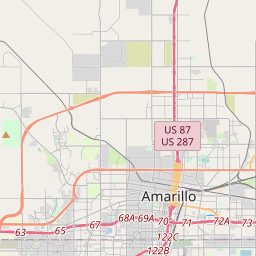Atchison, Topeka & Santa Fe Railroad, The Amarillo Story
Historical marker location:






Construction of a railroad across the Panhandle led to the founding of Amarillo as County Seat of Potter County, Aug. 30, 1887.
For the ensuing ten years, Amarillo had a monopoly on trade from the South plains, and was the nation's largest rural cattle shipping point, 1892-97. But in 1898 its trade was threatened and the city's very existence jeopardized when it appeared that the (Santa Fe sponsored) Pecos Valley & North Eastern Railway, to be built to Roswell, N.M. (220 mi. SW), might make junction with the Santa Fe at Washburn (15 mi. SE), cutting off ready access to the South plains.
The Santa Fe, however, responded to requests from the citizens to make Amarillo the terminus of the new line. The Santa Fe acquired the Pecos Valley & North Eastern in 1899 and moved headquarters from Panhandle (30 mi. NE) to Amarillo. In 1908 the Santa Fe extended its main line here from Panhandle and built a link from Texico, N.M., to Belen, N.M., making Amarillo a major point on the transcontinental line.
These measures, together with construction of branch lines, contributed vitally to making Amarillo the commercial center of the High Plains.
(1973)
As one of the most visible programs of the Texas Historical Commission (THC), historical markers commemorate diverse topics in Texas history, including: the history and architecture of houses, commercial and public buildings, religious congregations, and military sites; events that changed the course of local and state history; and individuals who have made lasting contributions to the state, community organizations, and businesses.
The first oil well in the United States was drilled in Texas in 1859. The discovery of oil transformed the economy of the state and helped to make Texas one of the wealthiest states in the nation.
In 1876, Potter County was officially established and named after Robert Potter, a lawyer and signer of the Texas Declaration of Independence. The county's first town, Amarillo, was founded soon after and quickly became the county seat. Initially, Amarillo served as a cattle shipping point and a center for trade, attracting businesses and settlers from surrounding areas.
The early 20th century brought significant development to Potter County. The discovery of oil in nearby areas in the 1920s led to a boom in the county, with oil companies setting up operations and bringing wealth and jobs to the region. This growth and prosperity continued throughout the 20th century, with Amarillo becoming a major economic and cultural hub in the Texas Panhandle.
Today, Potter County continues to thrive as a vibrant community. Its economy is diversified, with significant contributions from industries such as healthcare, education, agriculture, and tourism. The county boasts numerous parks, museums, and attractions, making it an attractive destination for visitors. With its rich history and ongoing growth, Potter County remains a significant contributor to the heritage and economy of Texas.
Potter County Timeline
This timeline provides a concise overview of the key events in the history of Potter County, Texas.
- Potter County is formed on August 21, 1876
- In 1886, Amarillo becomes the county seat of Potter County
- The first courthouse in Potter County is built in 1887
- The first oil well is drilled in Potter County in 1921
- Potter County experiences significant growth during the oil boom of the 1920s
- Palo Duro Canyon State Park is established in Potter County in 1934
- In 1951, the Pantex Plant is established in Potter County, becoming a key facility for the assembly and disassembly of nuclear weapons
- The Tri-State Fair & Rodeo, held annually in Potter County, celebrates its 100th anniversary in 2021